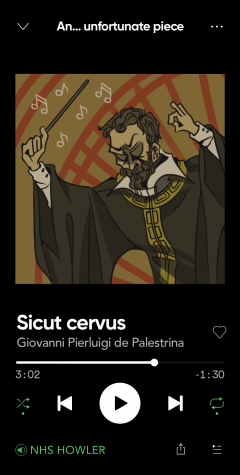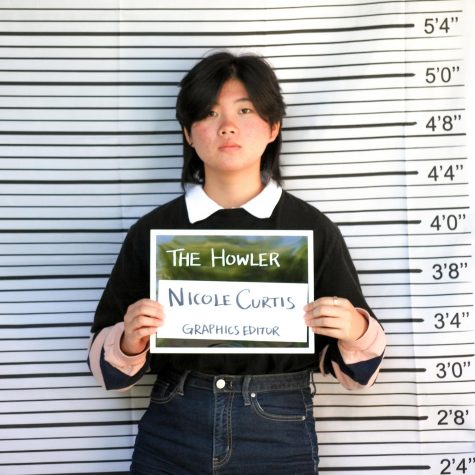SATIRE – Sicut Cervus: An…unfortunate piece
Erin Tsai, Staff Writer
October 3, 2021
SATIRE
“Sicut Cervus” is Giovanni Pierluigi de Palestrina’s latest banger of the 1500s. As a leading expert on new musical releases, I will comprehensively rate “Sicut Cervus” based on four vital criteria: composition, lyrics, performance quality and if it suits my personal tastes.
Composition
The most immediate detriment to “Sicut Cervus” was the missing dynamics throughout the piece. How does a Renaissance-style piece not include modern dynamics? I know that Renaissance pieces usually don’t have much dynamics, but Palestrina, I thought you were different. Additionally, the melody almost never has drastic changes in pitch. Are the singers so bad that they can’t sing with variety? Despite this calamity, I must admit that the polyphonism of the piece is still impressive. Every voice part had its own phrasing and markings, essentially making “Sicut Cervus” four separate pieces skillfully mishmashed into one. I would tell Palestrina to hold a Masterclass on polyphonic music, except I’m afraid he’d influence up-and-coming composers into creating an era of boring music. 3/10.
Lyrics
Palestrina, did you even proofread these lyrics before you released “Sicut Cervus”? The entire piece is repeating a single sentence for three minutes. It’s not even a particularly nice sentence. The English translation of the original Latin lyrics is as follows: “Like as the hart desireth the water-brooks: so longeth my soul after thee, O God.” In normal English, that means, “The deer longs for springwater like my soul longs for you, God.” How does this make sense? If the deer longs for springwater, it can just go drink springwater. The use of visual imagery and symbolism of the deer and springwater is quite ineffective due to how short the lyrics are and the lack of greater context behind the lyrical meaning. Moreover, the allusion to God is not very religiously inclusive for non-Bible believers. The lyrics were the greatest letdown, especially since the tone sounded so elegant in comparison. -17/10.
Performance
I was initially impressed with how smooth each of the parts sounded, not only within the parts but also throughout the chorus. But, I noticed that there are no existing recordings of performances of the piece from the original time period, which is disappointing to say the least. The thing I am the most angry about is the anti-feminist sentiment in this piece. “Sicut Cervus” is written for an all-men’s chorus, using young boys to take the place of sopranos and altos. This is clear discrimination against female singers, and therefore, all women. What kind of precedent are you setting for girls who want to be singers and musicians? How do you expect women to listen to your music without any proper representation? I’m hoping that you didn’t do this with ill intent and take this as an opportunity to educate yourself on the importance of feminism. 6/10.
Personal taste
This is by far the most crucial and important of the four criteria. Honestly, it wasn’t that bad, but I definitely had higher expectations for Palestrina. The piece was pretty, but to be honest, it was kind of bland, especially in comparison to the Top 100 songs of the modern era. I’m sorry to say this, but if “Sicut Cervus” is indicative of all Renaissance music, then the Renaissance era probably went out of style for a reason. Even though it had its moments, as a piece overall, “Sicut Cervus” was quite… unfortunate. I really suggest some further research on the composer’s part. 4/10.
Note: The Howler reached out to Giovanni Pierluigi de Palestrina for comment but has not received a response as of Sept. 28.




![AAAAAND ANOTHER THING: [CENSORED] [REDACTED] [BABY SCREAMING] [SIRENS] [SILENCE].](https://thehowleronline.org/wp-content/uploads/2025/06/lucy-1200x800.jpg)

















































![AAAAAND ANOTHER THING: [CENSORED] [REDACTED] [BABY SCREAMING] [SIRENS] [SILENCE].](https://thehowleronline.org/wp-content/uploads/2025/06/lucy-300x200.jpg)




John Ockwell
Mar 1, 2024 at 1:54 pm
Sadly Erin…you’ve missed the point …you can’t talk about performance when just looking at the score…there will be as many different perrformances as the are people who sing this exquisite genre of music. Just live alittle more and listen to a wider range of music and you will perhaps see the beauty on simplicity…D.Mus.Ed. ( Sydney Uni)music teachet and lecturer for 40 years
adviser
Mar 23, 2024 at 3:09 pm
Thank you for your comment. This is a piece of satirical writing. Perhaps you could seek out a wider range of satire and you will see the beauty of the simplicity of a satirical music review.
Ben Hawker
Sep 29, 2024 at 6:30 pm
You spelled “teacher” and “performances” and “a little” wrong.
College dropout
Bill Braskey
Mar 29, 2023 at 2:44 pm
This is a great way to get people taking about real music! Make paperwork’s controversial lol!
Ami
Mar 20, 2023 at 4:15 pm
Perhaps a valuable lesson in writing satire… give the reader some clues before the halfway mark, otherwise you’ll end up with most of your audience seeing red, and unwilling to read far enough to get to the funny bits. Nice narrative voice, though!
Noel Coogan
Oct 27, 2023 at 2:22 am
I just came across this article, what a hoot !
Mark
Oct 10, 2022 at 1:13 pm
Study counterpoint, then you’ll understand why each part was written the way it was. What a completely uninformed piece you’ve written.
Student Editor
Oct 11, 2022 at 3:29 pm
This piece is satirical
Aleksis
Sep 19, 2022 at 1:26 pm
Don’t agree with your opinion even if it is tongue in cheek. I love this piece and especially enjoy singing it in choir, one of my favourites. I’d be surprised if any modern music is still being sung in 40 years, let alone 400.
Saundra Stephenson
Aug 15, 2022 at 10:20 am
Why would a renaissance piece include modern dynamics? That’s an interesting hill to die on. Dynamics were not commonly used until the 17th century, after Palestrina had long been reduced to bones in his grave.
After reading more of your review, I see that it is satire. Hehe.
Julia Peden
Jul 2, 2022 at 8:06 pm
This is Scripture.
Psalm 42:1
As the hart (deer) panteth after the water brooks, so panteth my soul after Thee, O God.
Showing the desire of Psalmest and that should be the longing of every Christian
James Pakala
Mar 25, 2022 at 8:04 pm
Anachronistic is the criticism based on feminism. Today both all male and all female as well as mixed choirs and children’s choirs are delightful.
Sarah Carpetner
Jul 2, 2022 at 12:36 pm
I have to ask how Erin ever attained the position as staff writer…here critique was as far off the mark as was ever possible. Perhaps it would help to research the religious and political climate of the time.
Reverend (Dr.) Sarah Carpenter, PhD DD
adviser
Sep 19, 2022 at 3:46 pm
Her critique being off the mark was the point. This is satirical.
Marianne Orlando
Mar 7, 2023 at 9:45 am
The author is poking fun at music critics in general, and opinionated ones in particular. As more than one person said, this is meant to be satirical.
Marianne